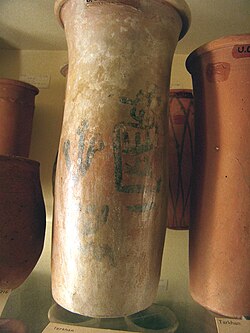| Ka | ||||||||||||||||||||||||||||||||
|---|---|---|---|---|---|---|---|---|---|---|---|---|---|---|---|---|---|---|---|---|---|---|---|---|---|---|---|---|---|---|---|---|
| Sekhen | ||||||||||||||||||||||||||||||||
 | ||||||||||||||||||||||||||||||||
| Pharaoh | ||||||||||||||||||||||||||||||||
| Reign | 32nd century BC | |||||||||||||||||||||||||||||||
| Predecessor | Iry-Hor | |||||||||||||||||||||||||||||||
| Successor | Scorpion II?, Narmer? | |||||||||||||||||||||||||||||||
| ||||||||||||||||||||||||||||||||
| Consort | Ha [1] | |||||||||||||||||||||||||||||||
| Burial | Chambers B7, B9, Umm el-Qa'ab | |||||||||||||||||||||||||||||||
| Dynasty | Dynasty 0 | |||||||||||||||||||||||||||||||
Ka, also (alternatively) Sekhen, [2] [3] was a Predynastic pharaoh of Upper Egypt belonging to Dynasty 0. He probably reigned during the first half of the 32nd century BC. The length of his reign is unknown.







